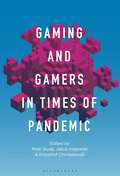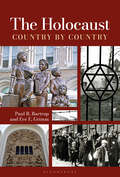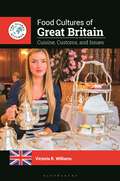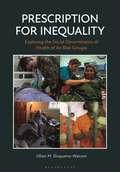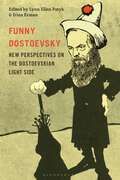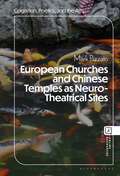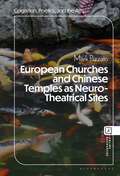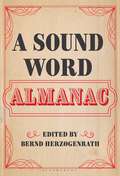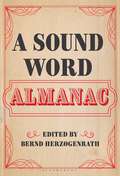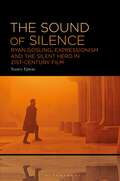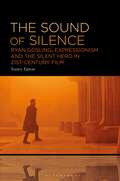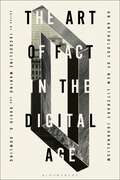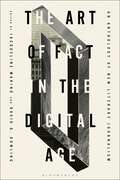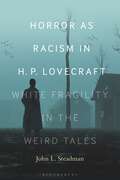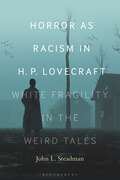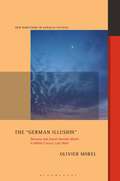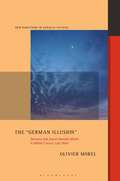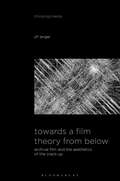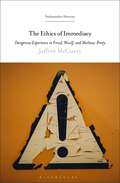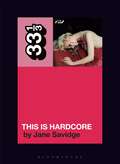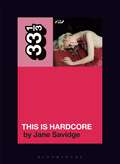- Table View
- List View
Gaming and Gamers in Times of Pandemic
This edited collection brings in multiple scholarly perspectives to examine the impact of the pandemic and resulting government policies, especially lockdowns, on one particular cultural sphere: games.The COVID-19 pandemic has impacted virtually every aspect of our lives, regardless of where we live. In the initial months, many industry reports noted the unexpected positive impact on online digital game sales. Games were not just lockdown-proof, but boosted by lockdowns. Stay-at-home orders triggered a rush toward games as an alternative form of entertainment, and the ubiquity of mobile phones allowed wider than ever participation. Gaming and Gamers in Times of Pandemic studies how the COVID-19 pandemic affected game players, game developers, game journalists and game scholars alike in many other ways, starting with the most direct – illness, and sometimes death. Some effects are temporary, others are here to stay.
Gaming and Gamers in Times of Pandemic
by Piotr SiudaThis edited collection brings in multiple scholarly perspectives to examine the impact of the pandemic and resulting government policies, especially lockdowns, on one particular cultural sphere: games.The COVID-19 pandemic has impacted virtually every aspect of our lives, regardless of where we live. In the initial months, many industry reports noted the unexpected positive impact on online digital game sales. Games were not just lockdown-proof, but boosted by lockdowns. Stay-at-home orders triggered a rush toward games as an alternative form of entertainment, and the ubiquity of mobile phones allowed wider than ever participation. Gaming and Gamers in Times of Pandemic studies how the COVID-19 pandemic affected game players, game developers, game journalists and game scholars alike in many other ways, starting with the most direct – illness, and sometimes death. Some effects are temporary, others are here to stay.
The Holocaust: Country by Country
by Eve E. Grimm Professor Paul R. BartropFrom genocidal campaigns to careful neutrality to valiant lifesaving efforts, every country's experience of the Holocaust was different during and immediately following World War II.This book profiles 50 nations and territories from around the globe, examining how prewar conditions and attitudes toward Jews influenced the trajectory of that place's wartime experience and its role in the Holocaust. It also explores the aftermath and lasting impact of the Holocaust in these places. Each profile begins with a collection of at-a-glance facts about population, government leaders, wartime status, and more. All profiles begin with a brief introduction, followed by information about the Jewish population in that place, the prewar environment, wartime experiences, and the aftermath of the Holocaust. This standardized format makes it easy for readers to find specific information while also helping them place events within the proper historical context. A curated selection of further readings at the end of each profile and an end-of-volume list of books and Internet resources point readers toward materials for additional study.While often conceptualized as a single event that happened the same way across all Axis or Axis-occupied countries, the Holocaust and reactions to it varied widely from country to country. In many cases, political and economic conditions in the prewar years, as well as the degree of anti-Semitism in a nation, influenced that country's experience of the Holocaust. Even after the war, countries experienced the aftermath of the Holocaust in different ways. Some places, such as Palestine, became a beacon for Jewish refugees, while others, such as Brazil, became a hideout for Nazi war criminals.
Food Cultures of Great Britain: Cuisine, Customs, and Issues (The Global Kitchen)
by Victoria R. WilliamsThere's far more to British food than fish and chips. Discover the history and culture of Great Britain through its rich culinary traditions.Part of the Global Kitchen series, this book takes readers on a food tour of Great Britain, covering everything from daily staples to holiday specialties. In addition to discovering Great Britain's long culinary history, you'll learn about recent trends, foreign influences, and contemporary food and dietary concerns, such as obesity and the impacts of climate change. Chapters are organized thematically, making it easy to focus in on particular courses or types of dishes. The main text is supplemented by sidebars that offer interesting bite-sized facts, a chronology of important dates in British culinary history, and a glossary of key food- and dining-related terms.When people outside Great Britain think of British cuisine, they likely envision iconic foods and traditions such as fish and chips, a full English breakfast, and afternoon tea. But Great Britain has a much richer and more diverse culinary history. It has been shaped by a myriad of events, from invasions by the Romans, Vikings, and Normans to the emergence and expansion of the British Empire to the privations of World War II. In more recent times, Great Britain's departure from the European Union, the global Covid-19 pandemic, and Russia's invasion of Ukraine have all had a significant impact on the food landscape of Great Britain.
Prescription for Inequality: Exploring the Social Determinants of Health of At-Risk Groups
by Jillian M. Duquaine-WatsonThis book explores how social determinants of health (SDH) impact the health of a variety of marginalized demographic groups in the United States. Chapters focus on the 13 groups that research demonstrates are most disadvantaged by SDH and, consequently, who suffer the most from ongoing health disparities in America. This includes Black and Hispanic individuals, the LGBTQIA+ community, women, the elderly, people with disabilities, veterans, and those living in rural areas, among others.Chapters follow a standardized format that makes it easy for readers to focus in on aspects of the subject that are of greatest interest. Each profile begins with a snapshot of that group's current state of health, including the biggest medical concerns and how other determinants of health may play a role. Next, each chapter takes an in-depth look at the four components of SDH: economic factors, educational access and quality, healthcare access and quality, and living environment and social context. Unique problems and possible solutions are explored within each of these four sections. An end-of-volume bibliography and further readings list points readers who wish to continue their investigation of the topic toward additional information.Relying on an interdisciplinary framework, the book incorporates research from diverse fields including public health, feminist theory, critical studies of race and ethnicity, poverty studies, disability studies, aging studies, cultural competence, legal studies, and global health. In recognition of the reality that health disparities are the result of a complex interplay of forces and structural factors that permeate American culture, analysis extends beyond health and health care to include a broad range of interrelated social, political, economic, and educational components.
Funny Dostoevsky: New Perspectives on the Dostoevskian Light Side
Tapping into the emergence of scholarly comedy studies since the 2000s, this collection brings new perspectives to bear on the Dostoevskian light side. Funny Dostoevksy demonstrates how and why Dostoevsky is one of the most humorous 19th-century authors, even as he plumbs the depths of the human psyche and the darkest facets of European modernity. The authors go beyond the more traditional categories of humor, such as satire, parody, and the carnivalesque, to apply unique lenses to their readings of Dostoevsky. These include cinematic slapstick and the body in Crime and Punishment, the affective turn and hilarious (and deadly) impatience in Demons, and ontological jokes in Notes from Underground and The Idiot. The authors – (coincidentally?) all women, including some of the most established scholars in the field alongside up-and-comers – address gender and the marginalization of comedy, culminating in a chapter on Dostoevsky's "funny and furious" women, and explore the intersections of gender and humor in literary and culture studies. Funny Dostoevksy applies some of the latest findings on humor and laughter to his writing, while comparative chapters bring Dostoevsky's humor into conjunction with other popular works, such as Chaplin's Modern Times and Lin-Manuel Miranda's Hamilton. Written with a verve and wit that Dostoevsky would appreciate, this boldly original volume illuminates how humor and comedy in his works operate as vehicles of deconstruction, pleasure, play, and transcendence.
Funny Dostoevsky: New Perspectives on the Dostoevskian Light Side
by Lynn Ellen Patyk and Irina ErmanTapping into the emergence of scholarly comedy studies since the 2000s, this collection brings new perspectives to bear on the Dostoevskian light side. Funny Dostoevksy demonstrates how and why Dostoevsky is one of the most humorous 19th-century authors, even as he plumbs the depths of the human psyche and the darkest facets of European modernity. The authors go beyond the more traditional categories of humor, such as satire, parody, and the carnivalesque, to apply unique lenses to their readings of Dostoevsky. These include cinematic slapstick and the body in Crime and Punishment, the affective turn and hilarious (and deadly) impatience in Demons, and ontological jokes in Notes from Underground and The Idiot. The authors – (coincidentally?) all women, including some of the most established scholars in the field alongside up-and-comers – address gender and the marginalization of comedy, culminating in a chapter on Dostoevsky's "funny and furious" women, and explore the intersections of gender and humor in literary and culture studies. Funny Dostoevksy applies some of the latest findings on humor and laughter to his writing, while comparative chapters bring Dostoevsky's humor into conjunction with other popular works, such as Chaplin's Modern Times and Lin-Manuel Miranda's Hamilton. Written with a verve and wit that Dostoevsky would appreciate, this boldly original volume illuminates how humor and comedy in his works operate as vehicles of deconstruction, pleasure, play, and transcendence.
European Churches and Chinese Temples as Neuro-Theatrical Sites (Cognition, Poetics, and the Arts)
by Prof. or Dr. Mark PizzatoCompares monumental designs and performance spaces of Christian, Buddhist, and related sanctuaries, exploring how brain networks, animal-human emotions, and cultural ideals are reflected historically and affected today as "inner theatre" elements. Integrating research across the humanities and sciences, this book explores how traditional designs of outer theatrical spaces left cultural imprints for the inner staging of Self and Other consciousness, which each of us performs daily based on how we think others view us. But believers also perform in a cosmic theatre. Ancestral spirits and gods (or God) watch and interact with them in awe-inspiring spaces, grooming affects toward in-group identification and sacrifice, or out-group rivalry and scapegoating. In a study of over 80 buildings – shown by 40 images in the book, plus thousands of photos and videos online – Pizzato demonstrates how they reflect meta-theatrical projections from prior generations. They also affect the embodied, embedded, enacted, and extended (4E) cognition of current visitors, who bring performance frameworks of belief, hope, and doubt to the sacred site. This involves neuro-social, inner/outer theatre networks with patriarchal, maternal, and trickster paradigms. European Churches and Chinese Temples as Neuro-Theatrical Sites investigates performative material cultures, creating dialogs between theatre, philosophy, history, and various (cognitive, affective, social, biological) sciences. It applies them to the architecture of religious buildings: from Catholic, Orthodox, and Protestant in Europe, plus key sites in Jerusalem and prior “pagan” temples, to Buddhist, Daoist, Confucian, and imperial in China. It thus reveals individualist/collectivist, focal/holistic, analytical/dialectical, and melodramatic/tragicomic trajectories, with cathartic poetics for the future.
European Churches and Chinese Temples as Neuro-Theatrical Sites (Cognition, Poetics, and the Arts)
by Prof. or Dr. Mark PizzatoCompares monumental designs and performance spaces of Christian, Buddhist, and related sanctuaries, exploring how brain networks, animal-human emotions, and cultural ideals are reflected historically and affected today as "inner theatre" elements. Integrating research across the humanities and sciences, this book explores how traditional designs of outer theatrical spaces left cultural imprints for the inner staging of Self and Other consciousness, which each of us performs daily based on how we think others view us. But believers also perform in a cosmic theatre. Ancestral spirits and gods (or God) watch and interact with them in awe-inspiring spaces, grooming affects toward in-group identification and sacrifice, or out-group rivalry and scapegoating. In a study of over 80 buildings – shown by 40 images in the book, plus thousands of photos and videos online – Pizzato demonstrates how they reflect meta-theatrical projections from prior generations. They also affect the embodied, embedded, enacted, and extended (4E) cognition of current visitors, who bring performance frameworks of belief, hope, and doubt to the sacred site. This involves neuro-social, inner/outer theatre networks with patriarchal, maternal, and trickster paradigms. European Churches and Chinese Temples as Neuro-Theatrical Sites investigates performative material cultures, creating dialogs between theatre, philosophy, history, and various (cognitive, affective, social, biological) sciences. It applies them to the architecture of religious buildings: from Catholic, Orthodox, and Protestant in Europe, plus key sites in Jerusalem and prior “pagan” temples, to Buddhist, Daoist, Confucian, and imperial in China. It thus reveals individualist/collectivist, focal/holistic, analytical/dialectical, and melodramatic/tragicomic trajectories, with cathartic poetics for the future.
A Sound Word Almanac
This almanac of sound words important to artists and scholars highlights words that expand the way we speak (and write) about sonic experiences.Why write about sound, and how? If sonic philosophy is the attempt "to think about sound by philosophical means," then a metaphilosophical debate appears almost immediately on the horizon: What is called for is an understanding about sound and language, but also about the preconditions of musical understanding. What is at stake is the question of language and sound, as well as expanding how we speak about sonic experience.This almanac tackles these questions from artistic, experimental and personal perspectives. An assemblage of nearly 70 practitioners and theoreticians, artists and scholars offer their favorite 'sound word.' These sound words are onomatopoetical, mythological, practical; words of personal importance to the artists and their craft; words from their memory, related to sound. Many entries are not in English – some are untranslatable – and all are accompanied by a personal, explanatory, poetic entry. These are words that have the potential to change our perspective on listening-musicking-thinking.
A Sound Word Almanac
by Bernd HerzogenrathThis almanac of sound words important to artists and scholars highlights words that expand the way we speak (and write) about sonic experiences.Why write about sound, and how? If sonic philosophy is the attempt "to think about sound by philosophical means," then a metaphilosophical debate appears almost immediately on the horizon: What is called for is an understanding about sound and language, but also about the preconditions of musical understanding. What is at stake is the question of language and sound, as well as expanding how we speak about sonic experience.This almanac tackles these questions from artistic, experimental and personal perspectives. An assemblage of nearly 70 practitioners and theoreticians, artists and scholars offer their favorite 'sound word.' These sound words are onomatopoetical, mythological, practical; words of personal importance to the artists and their craft; words from their memory, related to sound. Many entries are not in English – some are untranslatable – and all are accompanied by a personal, explanatory, poetic entry. These are words that have the potential to change our perspective on listening-musicking-thinking.
The Sound of Silence: Ryan Gosling, Expressionism and the Silent Hero in 21st-Century Film
by Nancy EptonThe Sound of Silence explores how non-verbal communication in film, shown primarily through the acting of Ryan Gosling, provides an expressive space in which passive audience viewing is made more active by removing the expository signifier of dialogue. The German Expressionist era may have been brief, but the shadows cast since its end nonetheless loom large. The silhouetted, cigar-wielding men of film noir and their respectively dark, doom-laden haunts mirror the angst-inducing atmospheres of their forebearers, while also introducing the now-familiar figure of the silent hero. Considering the numerous silent hero actors in film history, there's one that stands out in the 21st century like no other: Ryan Gosling. His later career has seen some of the most iconic silent heroes of the past decade, with films such as Drive, Only God Forgives, Blade Runner 2049 and First Man cementing him as the go-to guy for a monosyllabic, taciturn and moody hero whose actions speak louder than words. This book argues that it is Gosling's expressive capabilities that keep audiences compelled by his performances. With the use of non-verbal silence – combined with its counterbalance, sound – a more active, emotive audience response can be achieved. Looking further into this idea through theorists such as Michel Chion and Susan Sontag, the book demonstrates that the sound of silence is one of the most meaningful cinematic sounds of all.
The Sound of Silence: Ryan Gosling, Expressionism and the Silent Hero in 21st-Century Film
by Nancy EptonThe Sound of Silence explores how non-verbal communication in film, shown primarily through the acting of Ryan Gosling, provides an expressive space in which passive audience viewing is made more active by removing the expository signifier of dialogue. The German Expressionist era may have been brief, but the shadows cast since its end nonetheless loom large. The silhouetted, cigar-wielding men of film noir and their respectively dark, doom-laden haunts mirror the angst-inducing atmospheres of their forebearers, while also introducing the now-familiar figure of the silent hero. Considering the numerous silent hero actors in film history, there's one that stands out in the 21st century like no other: Ryan Gosling. His later career has seen some of the most iconic silent heroes of the past decade, with films such as Drive, Only God Forgives, Blade Runner 2049 and First Man cementing him as the go-to guy for a monosyllabic, taciturn and moody hero whose actions speak louder than words. This book argues that it is Gosling's expressive capabilities that keep audiences compelled by his performances. With the use of non-verbal silence – combined with its counterbalance, sound – a more active, emotive audience response can be achieved. Looking further into this idea through theorists such as Michel Chion and Susan Sontag, the book demonstrates that the sound of silence is one of the most meaningful cinematic sounds of all.
The Art of Fact in the Digital Age: An Anthology of New Literary Journalism
by Jacqueline Marino and David O. DowlingThe Art of Fact in the Digital Age is a showcase of the most powerful and moving journalism of the past 25 years. Selections include stories originally published in established bastions of literary journalism (The New York Times, The Atlantic and The New Yorker), as well as those from specialized and online publications (Runner's World, The Atavist). It features writers of extraordinary style (including Carina del Valle Schorske, Brian Phillips, and Jia Tolentino), as well as those who have profoundly influenced public discourse on the 21st century's most urgent issues: Mitchell S. Jackson, Clint Smith, and Ta-Nehisi Coates on race; Susan Dominus and Luke Mogelson on migration; and Kathryn Schulz and David Wallace-Wells on environmental threats. It even includes one story that expanded literary journalism's repertoire into audio (This American Life). This collection, assembled for students, scholars, and practitioners alike, also charts the evolution of digital longform journalism through its greatest achievements, from transitioning readers to screens to the integration of multimedia with words in service of meaning. The art of fact in the 21st century opened new ranges of expression to address such issues, while uniquely bearing the imprint of their generation's digital cultures and technologies. Although many forces compete for attention in the digital age, story triumphs. The works in this anthology show us why.
The Art of Fact in the Digital Age: An Anthology of New Literary Journalism
The Art of Fact in the Digital Age is a showcase of the most powerful and moving journalism of the past 25 years. Selections include stories originally published in established bastions of literary journalism (The New York Times, The Atlantic and The New Yorker), as well as those from specialized and online publications (Runner's World, The Atavist). It features writers of extraordinary style (including Carina del Valle Schorske, Brian Phillips, and Jia Tolentino), as well as those who have profoundly influenced public discourse on the 21st century's most urgent issues: Mitchell S. Jackson, Clint Smith, and Ta-Nehisi Coates on race; Susan Dominus and Luke Mogelson on migration; and Kathryn Schulz and David Wallace-Wells on environmental threats. It even includes one story that expanded literary journalism's repertoire into audio (This American Life). This collection, assembled for students, scholars, and practitioners alike, also charts the evolution of digital longform journalism through its greatest achievements, from transitioning readers to screens to the integration of multimedia with words in service of meaning. The art of fact in the 21st century opened new ranges of expression to address such issues, while uniquely bearing the imprint of their generation's digital cultures and technologies. Although many forces compete for attention in the digital age, story triumphs. The works in this anthology show us why.
Horror as Racism in H. P. Lovecraft: White Fragility in the Weird Tales
by Dr. or Prof. John L. SteadmanProviding a new perspective on Lovecraft's life and work, Horror as Racism in H.P. Lovecraft focuses on the overlap between the writer's personal beliefs and the racist images and narratives in his speculative fiction. Building on recent debates about Lovecraft and drawing on the concept of "white fragility," John Steadman argues that the writer's fiction reflects his feelings of resentment and anger towards non-white persons and was used to advocate for his racist, xenophobic political beliefs – that western civilization was in decline and slavery was justifiable among "superior" civilizations. In making these claims, Lovecraft's tales pit humans against extra-terrestrial aliens, developing a terrifying, futuristic vision of the Earth as a plantation planet. The familiar image of Lovecraft as a reclusive, creative genius and mentor to young writer-friends is dismantled through close readings of his fiction and nonfiction – including correspondence, essays, and poetry – and examination of his early biography. This image is replaced by that of a cruel, callous, and, at times, psychotic man, a violently vitriolic racist and white supremacist who hated most of the non-white races. While some will dismiss the author outright and others will read his fiction but ignore the racism, Horror as Racism in H.P. Lovecraft takes a middle ground: acknowledging Lovecraft's personal history and heinous intentions, it helps readers navigate the author's disturbing biography while also getting a better sense of the stories, which remain significant within American science fiction.
Horror as Racism in H. P. Lovecraft: White Fragility in the Weird Tales
by Dr. or Prof. John L. SteadmanProviding a new perspective on Lovecraft's life and work, Horror as Racism in H.P. Lovecraft focuses on the overlap between the writer's personal beliefs and the racist images and narratives in his speculative fiction. Building on recent debates about Lovecraft and drawing on the concept of "white fragility," John Steadman argues that the writer's fiction reflects his feelings of resentment and anger towards non-white persons and was used to advocate for his racist, xenophobic political beliefs – that western civilization was in decline and slavery was justifiable among "superior" civilizations. In making these claims, Lovecraft's tales pit humans against extra-terrestrial aliens, developing a terrifying, futuristic vision of the Earth as a plantation planet. The familiar image of Lovecraft as a reclusive, creative genius and mentor to young writer-friends is dismantled through close readings of his fiction and nonfiction – including correspondence, essays, and poetry – and examination of his early biography. This image is replaced by that of a cruel, callous, and, at times, psychotic man, a violently vitriolic racist and white supremacist who hated most of the non-white races. While some will dismiss the author outright and others will read his fiction but ignore the racism, Horror as Racism in H.P. Lovecraft takes a middle ground: acknowledging Lovecraft's personal history and heinous intentions, it helps readers navigate the author's disturbing biography while also getting a better sense of the stories, which remain significant within American science fiction.
The "German Illusion": Germany and Jewish-German Motifs in Hélène Cixous’s Late Work (New Directions in German Studies)
by Professor or Dr. Olivier MorelExamines Jewish-German “tropes” in Hélène Cixous's oeuvre and life and their impact on her work as a feminist, poet, and playwright.Hélène Cixous is a poet, philosopher, and activist known worldwide for her manifesto on Écriture feminine (feminine writing) and for her influential literary texts, plays, and essays. While the themes were rarely present in her earlier writings, Germany and Jewish-German family figures and topics have significantly informed most of Cixous's late works. Born in Algeria in June 1937, she grew up with a mother who had escaped Germany after the rise of Nazism and a grandmother who fled the racial laws of the Third Reich in 1938. In her writing, Cixous refines the primitive scene of a “German” upbringing in French-occupied colonial, antisemitic Algeria.Scholar and filmmaker Olivier Morel delves into the signs and influences that “Germany,” “German,” and “Osnabrück” have exerted over Cixous's work. Featuring an exclusive interview with Hélène Cixous and stills from their travel together to Osnabrück in Morel's 2018 documentary, Ever, Rêve, Hélène Cixous, Morel's The “German Illusion” examines the unique literary meditation on the Holocaust sustained throughout her later texts. Morel helps us to understand an uncannily original oeuvre that embodies the complexities of modernity's genocidal history in a new way.
The "German Illusion": Germany and Jewish-German Motifs in Hélène Cixous’s Late Work (New Directions in German Studies)
by Professor or Dr. Olivier MorelExamines Jewish-German “tropes” in Hélène Cixous's oeuvre and life and their impact on her work as a feminist, poet, and playwright.Hélène Cixous is a poet, philosopher, and activist known worldwide for her manifesto on Écriture feminine (feminine writing) and for her influential literary texts, plays, and essays. While the themes were rarely present in her earlier writings, Germany and Jewish-German family figures and topics have significantly informed most of Cixous's late works. Born in Algeria in June 1937, she grew up with a mother who had escaped Germany after the rise of Nazism and a grandmother who fled the racial laws of the Third Reich in 1938. In her writing, Cixous refines the primitive scene of a “German” upbringing in French-occupied colonial, antisemitic Algeria.Scholar and filmmaker Olivier Morel delves into the signs and influences that “Germany,” “German,” and “Osnabrück” have exerted over Cixous's work. Featuring an exclusive interview with Hélène Cixous and stills from their travel together to Osnabrück in Morel's 2018 documentary, Ever, Rêve, Hélène Cixous, Morel's The “German Illusion” examines the unique literary meditation on the Holocaust sustained throughout her later texts. Morel helps us to understand an uncannily original oeuvre that embodies the complexities of modernity's genocidal history in a new way.
Towards a Film Theory from Below: Archival Film and the Aesthetics of the Crack-Up (Thinking Media)
by Jiri AngerOperating between film theory, media philosophy, archival practice, and audiovisual research, Jiri Anger focuses on the relationship between figuration and materiality in early films, experimental found footage cinema, and video essays. Would it be possible to do film theory from below, through the perspective of moving-image objects, of their multifarious details and facets, however marginal, unintentional, or aleatory they might be? Could we treat scratches, stains, and shakes in archival footage as speculatively and aesthetically generative features? Do these material actors have the capacity to create “weird shapes” within the figurative image that decenter, distort, and transform the existing conceptual and methodological frameworks?Building on his theoretical as well as practical experience with the recently digitized corpus of the first Czech films, created by Jan Kríženecký between 1898 and 1911, the author demonstrates how technological defects and accidents in archival films shape their aesthetic function and our understanding of the materiality of film in the digital age. The specific clashes between the figurative and material spheres are understood through the concept of a “crack-up.” This term, developed by Francis Scott Fitzgerald and theoretically reimagined by Gilles Deleuze, allows us to capture the convoluted relationship between figuration and materiality as inherent to the medium of film, containing negativity and productivity, difference and simultaneity, contingency and fate, at the same time, even within the tiniest cinematic units.
Towards a Film Theory from Below: Archival Film and the Aesthetics of the Crack-Up (Thinking Media)
by Jiri AngerOperating between film theory, media philosophy, archival practice, and audiovisual research, Jiri Anger focuses on the relationship between figuration and materiality in early films, experimental found footage cinema, and video essays. Would it be possible to do film theory from below, through the perspective of moving-image objects, of their multifarious details and facets, however marginal, unintentional, or aleatory they might be? Could we treat scratches, stains, and shakes in archival footage as speculatively and aesthetically generative features? Do these material actors have the capacity to create “weird shapes” within the figurative image that decenter, distort, and transform the existing conceptual and methodological frameworks?Building on his theoretical as well as practical experience with the recently digitized corpus of the first Czech films, created by Jan Kríženecký between 1898 and 1911, the author demonstrates how technological defects and accidents in archival films shape their aesthetic function and our understanding of the materiality of film in the digital age. The specific clashes between the figurative and material spheres are understood through the concept of a “crack-up.” This term, developed by Francis Scott Fitzgerald and theoretically reimagined by Gilles Deleuze, allows us to capture the convoluted relationship between figuration and materiality as inherent to the medium of film, containing negativity and productivity, difference and simultaneity, contingency and fate, at the same time, even within the tiniest cinematic units.
The Ethics of Immediacy: Dangerous Experience in Freud, Woolf, and Merleau-Ponty (Psychoanalytic Horizons)
by Dr. Jeffrey McCurryDrawing connections between Freudian psychoanalysis, Virginia Woolf's criticism and fiction, and Maurice Merleau-Ponty's phenomenology, The Ethics of Immediacy recounts the far-reaching consequences of the modern turn towards a new ethics of immediacy. During the first half of the 20th century, a profound transformation – an existential revolution – took place in European culture in how human beings conceived of themselves. Inspired by Freud's psychoanalysis, a newfound appreciation for the realm of immediate experience in human life emerged. With Freud himself making a signal contribution to this existential revolution, and with Woolf and Merleau-Ponty taking up Freud's ideas in their own unique ways, all three figures began to regard first-order, spontaneous, direct, unselfconscious, concrete experience of self and world as standing at the heart of what it means to be human.Jeffrey McCurry describes how this new state of affairs stood in contrast to how immediate experience had been historically dismissed, devalued, repressed, and even negated in the fields of psychology, literature, and philosophy. This experience posed dangers to psychological stability, social order, and philosophical certainty. McCurry examines how Freud's psychoanalytic theory, Woolf's modernist criticism and fiction, and Merleau-Ponty's phenomenology, psychology, literature, and philosophy in turns embraced the risks and dangers of putting immediate experience as the center of humanity, of respecting, understanding, appreciating, and following the lead of immediate, spontaneous, pre-reflective, pre-evaluative, concrete experience in human life.
The Ethics of Immediacy: Dangerous Experience in Freud, Woolf, and Merleau-Ponty (Psychoanalytic Horizons)
by Dr. Jeffrey McCurryDrawing connections between Freudian psychoanalysis, Virginia Woolf's criticism and fiction, and Maurice Merleau-Ponty's phenomenology, The Ethics of Immediacy recounts the far-reaching consequences of the modern turn towards a new ethics of immediacy. During the first half of the 20th century, a profound transformation – an existential revolution – took place in European culture in how human beings conceived of themselves. Inspired by Freud's psychoanalysis, a newfound appreciation for the realm of immediate experience in human life emerged. With Freud himself making a signal contribution to this existential revolution, and with Woolf and Merleau-Ponty taking up Freud's ideas in their own unique ways, all three figures began to regard first-order, spontaneous, direct, unselfconscious, concrete experience of self and world as standing at the heart of what it means to be human.Jeffrey McCurry describes how this new state of affairs stood in contrast to how immediate experience had been historically dismissed, devalued, repressed, and even negated in the fields of psychology, literature, and philosophy. This experience posed dangers to psychological stability, social order, and philosophical certainty. McCurry examines how Freud's psychoanalytic theory, Woolf's modernist criticism and fiction, and Merleau-Ponty's phenomenology, psychology, literature, and philosophy in turns embraced the risks and dangers of putting immediate experience as the center of humanity, of respecting, understanding, appreciating, and following the lead of immediate, spontaneous, pre-reflective, pre-evaluative, concrete experience in human life.
Pulp's This Is Hardcore (33 1/3)
by Jane SavidgeThis Is Hardcore is Pulp's cry for help. A giant, sprawling, flawed masterpiece of a record, the 1998 album manages to tackle some of the most inappropriate grown-up issues of the day – fame, ageing, mortality, drugs, and pornography – and still come out crying and laughing on the other side. The subject of pornography dominates the record – from its controversial artwork to the images conjured up by songs like "Seductive Barry" and the title track – after Pulp's main man, Jarvis Cocker – who'd spent most of his teenage and adult life chasing celebrity, only to be cruelly disappointed when it finally arrived in spades – hit upon the grand notion of using pornography as a metaphor for fame. The album's commercial failure as a follow-up to the band's Britpop-defining, Different Class, also symbolizes a death knell for Britpop itself. Dark, right? Except just like Pulp themselves, Jane Savidge's book is playful and sometimes very funny indeed. Kicking off with an imaginary conversation between Jarvis Cocker and the people who run the Total Fame Solutions helpline, Savidge expertly guides us through the trials and tribulations of an album that begins with the so-called Michael Jackson Incident, when Cocker got up on stage at the 1996 Brit Awards and waggled his fully-clothed bum at the King of Pop. Pulp's This Is Hardcore may be a sleazy run through porn and mental demise, and an album that chronicles Cocker's continuing disillusionment with his newfound lot in life, but Savidge's book assesses the cultural and historical context of the album with insider knowledge and a sharp modern lens, ultimately making a case for it as one of the most important albums of the 1990s.
Pulp's This Is Hardcore (33 1/3)
by Jane SavidgeThis Is Hardcore is Pulp's cry for help. A giant, sprawling, flawed masterpiece of a record, the 1998 album manages to tackle some of the most inappropriate grown-up issues of the day – fame, ageing, mortality, drugs, and pornography – and still come out crying and laughing on the other side. The subject of pornography dominates the record – from its controversial artwork to the images conjured up by songs like "Seductive Barry" and the title track – after Pulp's main man, Jarvis Cocker – who'd spent most of his teenage and adult life chasing celebrity, only to be cruelly disappointed when it finally arrived in spades – hit upon the grand notion of using pornography as a metaphor for fame. The album's commercial failure as a follow-up to the band's Britpop-defining, Different Class, also symbolizes a death knell for Britpop itself. Dark, right? Except just like Pulp themselves, Jane Savidge's book is playful and sometimes very funny indeed. Kicking off with an imaginary conversation between Jarvis Cocker and the people who run the Total Fame Solutions helpline, Savidge expertly guides us through the trials and tribulations of an album that begins with the so-called Michael Jackson Incident, when Cocker got up on stage at the 1996 Brit Awards and waggled his fully-clothed bum at the King of Pop. Pulp's This Is Hardcore may be a sleazy run through porn and mental demise, and an album that chronicles Cocker's continuing disillusionment with his newfound lot in life, but Savidge's book assesses the cultural and historical context of the album with insider knowledge and a sharp modern lens, ultimately making a case for it as one of the most important albums of the 1990s.
